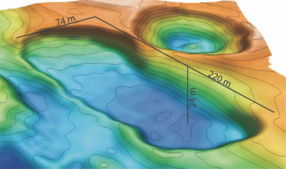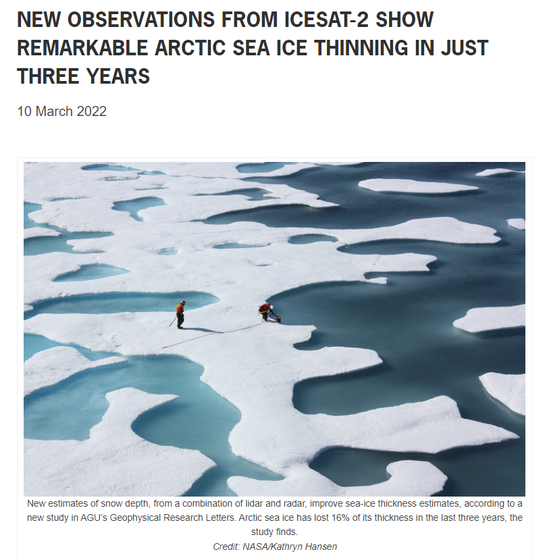Report that 'a large hole is open on the seabed of the Arctic Circle'

An American research team has announced the results of a survey that 'there is a large hole in the bottom of the Arctic Circle.' The research team commented, 'It is known that major changes are occurring in the entire Arctic Circle, but this is the first time that we have confirmed the changes on the seafloor.'
Rapid seafloor changes associated with the degradation of Arctic submarine permafrost | PNAS
https://www.pnas.org/doi/full/10.1073/pnas.2119105119
Mapping reveals rapid changes to the Arctic seafloor as ancient submerged permafrost thaws --MBARI
https://www.mbari.org/arctic-seafloor-mapping-permafrost/
The Monterey Bay Aquarium Research Institute, a non-profit marine research institute located in California, USA, reported the results of a new study that a large hole was opened in the seafloor due to the melting of permafrost in the Arctic Circle. An analysis of the results of a continuous seafloor survey of the Beaufort Sea, which is part of the Arctic Ocean, revealed that there were multiple large holes in the 10 years from 2010 to 2019.
Below is an image of the largest class among multiple large holes. It is difficult to express the shape of each of these holes because the outer shape is irregular, but roughly it is 220m long x 74m wide x 24m deep, and the institute says, 'A town with up to 6 stories. Is the size that fits in perfectly. '

In this study, these large holes were measured by a technique called ' multibeam echosounder '. The Monterey Bay Aquarium Research Institute conducted a survey in 2013, 2017, and 2019 to map the suburbs of the Beaufort Sea using an autonomous underwater vehicle that can measure the depth of the seabed with an accuracy of 1 meter in length and width. implementation. Since the hole in the seabed was growing rapidly after three measurements, a series of results were published as a paper.
In most cases, the rapid changes in nature in recent years are interpreted as being caused by climate change created by humankind, but the seafloor temperature of the Beaufort Sea does not show a tendency toward warming, so the research team 'reported this time. The big hole was not created directly by climate change. ' The research team speculates that the cause is ' brackish groundwater,' in which low-salinity water that springs from the ground melts the ice in the permafrost that accumulates on the seabed, forming underground cavities. It is speculated that a large sinkhole was created as a result of the collapse of this underground cavity.
In addition to this announcement, on March 10, 2022, a research team at the California Institute of Technology announced that 'the ice packs in the Arctic Ocean have become thinner in the last 18 years.' According to this report, not only has Arctic sea ice lost one-third of its volume in the last 18 years, but the most recent declining trend has been particularly pronounced, losing '16%' in three years. Yes, it seems that ice is disappearing both on the seabed and at sea.
New observations from ICESat-2 show remarkable Arctic sea ice thinning in just three years --AGU Newsroom
https://news.agu.org/press-release/new-observations-from-icesat-2-show-remarkable-arctic-sea-ice-thinning-in-just-three-years

Related Posts:
in Science, Posted by darkhorse_log







